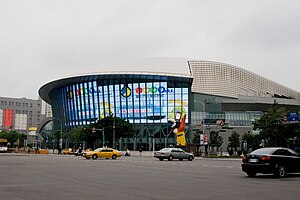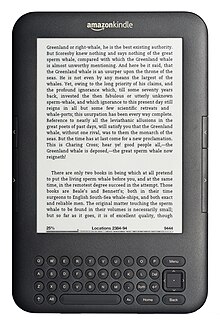利用者:加藤勝憲/フラットパネル・ディスプレイ

フラット・パネル・ディスプレイ(flat-panel display、FPD)は、テキストや画像などの視覚情報を表示するために使用されるディスプレイデバイスである。民生機器、医療機器、輸送機器、産業機器などに搭載されている。
フラット・パネル・ディスプレイは、薄型軽量で、直線性に優れ、以前の一般的な民生用テレビよりも高解像度である。通常、厚さは10cm未満である。民生用ブラウン管テレビの最高解像度は1080iであったが、2020年代のフラットパネル・ディスプレイの多くは1080pや4Kの解像度が可能である。
2010年代に入り、ノートパソコン、携帯電話、携帯カメラなどのポータブル家電では、消費電力が少なく軽量であることから、フラット・パネル・ディスプレイが採用されるようになった。2016年現在、フラット・パネル・ディスプレイはCRTディスプレイをほぼ完全に置き換えている。
2010年代のフラット・パネル・ディスプレイのほとんどは、液晶ディスプレイまたは発光ダイオード(LED)技術を使用しており、時には組み合わせて使用されることもある。ほとんどのLCDスクリーンはバックライト式で、色を表示するためにカラーフィルタが使われている。多くの場合、フラット・パネル・ディスプレイはタッチスクリーン・テクノロジーと組み合わされ、ユーザーが自然な形でディスプレイと対話できるようになっている。例えば、最近のスマートフォンのディスプレイには、静電容量式タッチスクリーンを備えたOLEDパネルがよく使われている。
Most 2010s-era flat-panel displays use LCD or light-emitting diode (LED) technologies, sometimes combined. Most LCD screens are back-lit with color filters used to display colors. In many cases, flat-panel displays are combined with touch screen technology, which allows the user to interact with the display in a natural manner. For example, modern smartphone displays often use OLED panels, with capacitive touch screens.
フラット・パネル・ディスプレイは、揮発性と静止性という2つのディスプレイ・デバイス・カテゴリーに分けられる。前者は、ピクセルの状態を保持するために定期的に電子的にリフレッシュする必要があり(液晶ディスプレイ(LCD)など)、電力があるときのみ画像を表示できる。一方、静的フラット・パネル・ディスプレイは、e-ink技術を利用したディスプレイのように、色状態が双安定である材料に依存しており、そのため、電源が切れてもコンテンツを保持することができる。
Flat-panel displays can be divided into two display device categories: volatile and static. The former requires that pixels be periodically electronically refreshed to retain their state (e.g. liquid-crystal displays (LCD)), and can only show an image when it has power. On the other hand, static flat-panel displays rely on materials whose color states are bistable, such as displays that make use of e-ink technology, and as such retain content even when power is removed.
History
[編集]薄型テレビの最初の技術提案は、1954年にゼネラル・エレクトリック社がレーダー・モニターの研究の結果として行った。その研究成果を発表したことで、将来の薄型テレビとモニターの基本がすべて明らかになった。しかし、GEは必要な研究開発を継続せず、その時点では実用的なフラットパネルを製造することはなかった[1]。最初の量産型フラットパネルディスプレイは、1950年代初頭に開発され、1958年に限定生産されたエイケン管であった。これは、ヘッドアップディスプレイやオシロスコープモニターとして軍用システムで使用されたが、従来の技術がその開発を追い越した。このシステムを家庭用テレビ用に商品化しようと試みたが、継続的な問題が発生し、このシステムは商業的に発売されることはなかった[2][3][4]。
ホログラフィーの発明者として知られるガーボル・デーネシュは、1958年に薄型CRTの特許を取得した。この特許はエイケン管ンのコンセプトと実質的に類似していたため、数年にわたる特許争いに発展した。エイケン管の特許は米国で、ガボールの特許は英国で出願され、訴訟が完了する頃には、商業的な側面はとっくに失効しており、2人は友人となった[5]。この頃、クライヴ・シンクレアはガボールの研究に出会い、それを商業化するために10年にわたる努力を始めたが、結局は失敗に終わった[6]。
フィルコ社のプレディクタは、(当時としては)比較的フラットなブラウン管のセットアップを特徴としており、1958年の発売と同時に、商業的に発売された最初の「フラットパネル」となったが、プレディクタは商業的に失敗した。『The History of Plasma Display Panels』によれば、プラズマディスプレイパネルは1964年にイリノイ大学で発明された[7]
Liquid-crystal displays (LC displays, or LCDs)
[編集]MOSFET(金属-酸化膜-半導体電界効果トランジスタ、またはMOSトランジスタ)は、1959年にベル研究所のモハメド・M・アタラ(Mohamed M. Atalla)とダウォン・カーン(Dawon Kahng)によって発明され[8]、1960年に発表された[9]。[TFTベースのLCDのアイデアは、1968年にRCA研究所のBernard J. Lechnerによって考案された[12]。B.J. Lechner、F.J. Marlowe、E.O. Nester、J. Tultsは1968年、標準的なディスクリートMOSFETを使用した動的散乱LCDでこのコンセプトを実証した[13]。
The MOSFET (metal–oxide–semiconductor field-effect transistor, or MOS transistor) was invented by Mohamed M. Atalla and Dawon Kahng at Bell Labs in 1959,[8] and presented in 1960.[9] Building on their work, Paul K. Weimer at RCA developed the thin-film transistor (TFT) in 1962.[10] It was a type of MOSFET distinct from the standard bulk MOSFET.[11] The idea of a TFT-based LCD was conceived by Bernard J. Lechner of RCA Laboratories in 1968.[12] B.J. Lechner, F.J. Marlowe, E.O. Nester and J. Tults demonstrated the concept in 1968 with a dynamic scattering LCD that used standard discrete MOSFETs.[13]
1968年、ウェスチングハウス・エレクトリック・コーポレーションのT. ピーター・ブロディの薄膜デバイス部門が、TFTを使用した初のアクティブマトリクス対応エレクトロルミネッセンス・ディスプレイ(ELD)を製造した[14]。Dixonは、ウェスチングハウス研究所の薄膜トランジスタ液晶ディスプレイ(TFT LCD)を初めて実証した[15][16]。BrodyとFang-Chen Luoは1974年、TFTを使用したフラットアクティブマトリクス液晶ディスプレイ(AM LCD)を初めて実証した[12]。
The first active-matrix addressed electroluminescent display (ELD) was made using TFTs by T. Peter Brody's Thin-Film Devices department at Westinghouse Electric Corporation in 1968.[14] In 1973, Brody, J. A. Asars and G. D. Dixon at Westinghouse Research Laboratories demonstrated the first thin-film-transistor liquid-crystal display (TFT LCD).[15][16] Brody and Fang-Chen Luo demonstrated the first flat active-matrix liquid-crystal display (AM LCD) using TFTs in 1974.[12]
1982年までに、LCD技術をベースにしたポケットLCDテレビが日本で開発された[17]。2.1インチのエプソンET-10[18] Epson Elfは、1984年に発売された最初のカラーLCDポケットテレビであった[19]。12]。2013年現在、現代の高解像度・高品質の電子視覚表示装置はすべて、TFTベースのアクティブ・マトリクス・ディスプレイを使用している[21]。
By 1982, pocket LCD TVs based on LCD technology were developed in Japan.[17] The 2.1-inch Epson ET-10[18] Epson Elf was the first color LCD pocket TV, released in 1984.[19] In 1988, a Sharp research team led by engineer T. Nagayasu demonstrated a 14-inch full-color LCD,[12][20] which convinced the electronics industry that LCD would eventually replace CRTs as the standard television display technology.[12] 2013年現在[update], all modern high-resolution and high-quality electronic visual display devices use TFT-based active-matrix displays.[21]
LED displays
[編集]これは、HP AssociatesおよびHP Labsのハワード・C・ボーデン(Howard C. Borden)、ジェラルド・P・ピギーニ(Gerald P. Pighini)、モハメド・M・アタラ(Mohamed M. Atalla)の研究チームによる、1962年から1968年にかけての実用的なLED技術の研究開発の成果であった[22]。1969年2月、彼らはHP Model 5082-7000 Numeric Indicatorを発表した[23]。これは最初の英数字LEDディスプレイであり、デジタルディスプレイ技術における革命であり、数字表示用のニキシー管に取って代わり、後のLEDディスプレイの基礎となった[24]。 1977年、James P Mitchellは、おそらく最も初期の単色フラットパネルLEDテレビディスプレイを試作し、後に実演した。
The first usable LED display was developed by Hewlett-Packard (HP) and introduced in 1968.[22] It was the result of research and development (R&D) on practical LED technology between 1962 and 1968, by a research team under Howard C. Borden, Gerald P. Pighini, and Mohamed M. Atalla, at HP Associates and HP Labs. In February 1969, they introduced the HP Model 5082-7000 Numeric Indicator.[23] It was the first alphanumeric LED display, and was a revolution in digital display technology, replacing the Nixie tube for numeric displays and becoming the basis for later LED displays.[24] In 1977, James P Mitchell prototyped and later demonstrated what was perhaps the earliest monochromatic flat-panel LED television display.
1987年には、イーストマン・コダックのチン・W・タンとスティーブン・ヴァン・スライクが、実用的な有機EL(OLED)デバイスを初めて製造した[25]。2003年には、ハイニックスが4,096色で点灯可能な有機ELドライバを製造した[26]。2004年には、ソニーのQualia 005が初のLEDバックライトLCDとなった[27]。2007年に発売されたソニーのXEL-1は、初の有機ELテレビとなった[28]。
Ching W. Tang and Steven Van Slyke at Eastman Kodak built the first practical organic LED (OLED) device in 1987.[25] In 2003, Hynix produced an organic EL driver capable of lighting in 4,096 colors.[26] In 2004, the Sony Qualia 005 was the first LED-backlit LCD.[27] The Sony XEL-1, released in 2007, was the first OLED television.[28]
Common types
[編集]Liquid-crystal display (LCD)
[編集]
電界効果LCDは、CRTスクリーンよりも軽量、コンパクト、ポータブル、安価、信頼性が高く、目に優しい。LCDスクリーンには、結晶性を示す液体である液晶の薄い層が使われている。これは、透明な電極を持つ2枚のガラス板の間に挟まれている。LCDの両側には2枚の偏光フィルムが配置されている。電極間に制御された電界を発生させることで、液晶のさまざまなセグメントやピクセルを活性化し、偏光特性を変化させることができる。これらの偏光特性は、液晶層の配向と使用される特定の電界効果に依存し、ツイストネマティック(TN)、インプレーンスイッチング(IPS)、または垂直配向(VA)のいずれかである。カラーは、個々のサブピクセルに適切なカラーフィルター(赤、緑、青)を適用することで生成される。LCディスプレイは、時計、電卓、携帯電話、テレビ、コンピューターモニター、ノートパソコンの画面など、さまざまな電子機器に使用されている。
Field-effect LCDs are lightweight, compact, portable, cheap, more reliable, and easier on the eyes than CRT screens. LCD screens use a thin layer of liquid crystal, a liquid that exhibits crystalline properties. It is sandwiched between two glass plates carrying transparent electrodes. Two polarizing films are placed at each side of the LCD. By generating a controlled electric field between electrodes, various segments or pixels of the liquid crystal can be activated, causing changes in their polarizing properties. These polarizing properties depend on the alignment of the liquid-crystal layer and the specific field-effect used, being either Twisted Nematic (TN), In-Plane Switching (IPS) or Vertical Alignment (VA). Color is produced by applying appropriate color filters (red, green and blue) to the individual subpixels. LC displays are used in various electronics like watches, calculators, mobile phones, TVs, computer monitors and laptops screens etc.
LED-LCD
[編集]初期の大型液晶ディスプレイの多くは、CCFL(冷陰極蛍光ランプ)を何本も使ったバックライトだった。しかし、ポケットサイズの小型機器では、ほとんどの場合、LEDが照明光源として使用されていた。LEDの改良に伴い、現在ではほとんどすべての新しいディスプレイがLEDバックライト技術を搭載している。画像は依然としてLCD層によって生成される。
Plasma panel
[編集]プラズマ・ディスプレイは、ネオンなどのガスで満たされた薄いギャップで隔てられた2枚のガラス板で構成されている。それぞれのプレートには、複数の平行電極が走っている。2枚のプレートの電極は互いに直角をなしている。各プレートに1つずつある2つの電極間に電圧をかけると、2つの電極にあるガスの小さなセグメントが光る。ガスセグメントの輝きは、すべての電極に連続的に印加される低電圧によって維持される。2010年までに、消費者向けのプラズマ・ディスプレイは、多くのメーカーが製造中止とした。
Electroluminescent panel
[編集]エレクトロルミネッセンス・ディスプレイ(ELD)では、蛍光体を光らせるプレートに電気信号を印加することで画像を作成する。
Organic light-emitting diode
[編集]OLED(有機発光ダイオード)は発光ダイオード(LED)であり、発光するエレクトロルミネッセンス層は有機化合物の膜で、電流に反応して発光する。この有機半導体の層は2つの電極の間にあり、通常、これらの電極の少なくとも一方は透明である。OLEDは、テレビ画面、コンピューター・モニター、携帯電話、携帯ゲーム機、PDAなどのポータブル・システムにおけるデジタル・ディスプレイの作成に使用されている。
An OLED (organic light-emitting diode) is a light-emitting diode (LED) in which the emissive electroluminescent layer is a film of organic compound which emits light in response to an electric current. This layer of organic semiconductor is situated between two electrodes; typically, at least one of these electrodes is transparent. OLEDs are used to create digital displays in devices such as television screens, computer monitors, portable systems such as mobile phones, handheld game consoles and PDAs.
Quantum-dot light-emitting diode
[編集]QLEDまたは量子ドットLEDは、サムスンがこの商標の下で導入したフラットパネルディスプレイ技術である。量子ドットは、青色LEDのような波長の短い光源に照らされると、独自の光を作り出す。このタイプのLEDテレビは、画像が依然としてLCDによって生成されるLCDパネルの色域を強化する。サムスンの見解では、大画面テレビ用の量子ドット・ディスプレイは、今後数年でOLEDディスプレイよりも普及すると予想されている。NanocoやNanosysのような企業は、QD材料を提供するために競争している。一方、スマートフォンなどのサムスン・ギャラクシー端末には、現在もサムスン製の有機ELディスプレイが搭載されている。サムスンは自社のウェブサイトで、同社が製造するQLEDテレビは、ディスプレイのどの部分にコントラストが必要かを判断できると説明している。サムスンはまた、新しいサムスンQLEDテレビを宣伝するマイクロソフトとの提携も発表した。
LED or quantum dot LED is a flat panel display technology introduced by Samsung under this trademark. Other television set manufacturers such as Sony have used the same technology to enhance the backlighting of LCD TVs already in 2013. Quantum dots create their own unique light when illuminated by a light source of shorter wavelength such as blue LEDs. This type of LED TV enhances the colour gamut of LCD panels, where the image is still generated by the LCD. In the view of Samsung, quantum dot displays for large-screen TVs are expected to become more popular than the OLED displays in the coming years; Firms like Nanoco and Nanosys compete to provide the QD materials. In the meantime, Samsung Galaxy devices such as smartphones are still equipped with OLED displays manufactured by Samsung as well. Samsung explains on their website that the QLED TV they produce can determine what part of the display needs more or less contrast. Samsung also announced a partnership with Microsoft that will promote the new Samsung QLED TV.
Volatile
[編集]
揮発性ディスプレイは、静止画像であっても、その状態を保持するためにピクセルを定期的にリフレッシュする必要がある。そのため、揮発性スクリーンは、ディスプレイ上の画像を維持したり画像を変更したりするために、主電源(コンセントに接続されている)またはバッテリーからの電力を必要とする。このリフレッシュは通常、1秒間に何度も行われる。これが行われないと、例えば停電があった場合、ピクセルは徐々にコヒーレントな状態を失い、画像はスクリーンから「フェード」してしまう。
Volatile displays require that pixels be periodically refreshed to retain their state, even for a static image. As such, a volatile screen needs electrical power, either from mains electricity (being plugged into a wall socket) or a battery to maintain an image on the display or change the image. This refresh typically occurs many times a second. If this is not done, for example, if there is a power outage, the pixels will gradually lose their coherent state, and the image will "fade" from the screen.
Examples
[編集]1990年代から2010年代にかけて、以下のフラットディスプレイ技術が実用化された:
- プラズマディスプレイパネル(PDP)
- アクティブマトリクス液晶ディスプレイ(AMLCD)
- リアプロジェクション:デジタル・ライト・プロセッシング(DLP)、LCD、LCOS
- 電子ペーパーEインク、ジャイコン
- 発光ダイオード・ディスプレイ(LED)
- アクティブマトリクス型有機発光ダイオード(AMOLED)
- 量子ドット・ディスプレイ(QLED)
広範に研究されたが、商業化が制限されたか、最終的に放棄された技術:
- アクティブマトリクス型エレクトロルミネッセンス・ディスプレイ(ELD)
- インターフェロメトリック・モジュレーター・ディスプレイ(IMOD)
- フィールド・エミッション・ディスプレイ(FED)
- 表面伝導電子エミッタ・ディスプレイ(SED、SED-TV)
- Active-matrix electroluminescent display (ELD)
- Interferometric modulator display (IMOD)
- Field emission display (FED)
- Surface-conduction electron-emitter display (SED, SED-TV)
Static
[編集]
スタティック・フラットパネル・ディスプレイは、色状態が双安定な材料に依存している。つまり、画像を維持するためのエネルギーは必要なく、代わりに変化するためのエネルギーが必要なのである。この結果、よりエネルギー効率の高いディスプレイになるが、リフレッシュ・レートが遅くなる傾向があり、インタラクティブ・ディスプレイには望ましくない。双安定フラット・パネル・ディスプレイは、限られた用途(屋外広告ではMagink社製のコレステリック液晶ディスプレイ、ソニーとアイレックスの電子書籍リーダー・デバイスでは電気泳動ディスプレイ、アンラベル、スマートウォッチではインターフェロメトリック・モジュレーター・ディスプレイ)で展開され始めている。
関連項目
[編集]- Computer monitor
- Display motion blur
- Electronic paper
- FPD-Link
- Flexible display
- Large-screen television technology
- LCD
- LED-backlit LCD television
- List of flat panel display manufacturers
- MicroLED
- Mobile display
- OLED
- Plasma display panel
- Quantum dot display
- Sony Watchman
- Stereoscopy 3D displays requiring no special glasses
- Touch panel
- Transparent display
脚注・参考文献
[編集]- ^ "Proposed Television Sets Would Feature Thin Screens." Popular Mechanics, November 1954, p. 111.
- ^ William Ross Aiken, "History of the Kaiser-Aiken, thin cathode ray tube", IEEE Transactions on Electron Devices, Volume 31 Issue 11 (November 1984), pp. 1605–1608.
- ^ “Flat Screen TV in 1958 – Popular Mechanics (Jan, 1958)”. Template:Cite webの呼び出しエラー:引数 accessdate は必須です。
- ^ “Geer Experimental Color CRT”. www.earlytelevision.org. Template:Cite webの呼び出しエラー:引数 accessdate は必須です。
- ^ Cobleigh, Jaimeson (30 October 1996). "Interview with William Ross Aiken" (PDF) (Interview). IEEE History Center'.
- ^ Adamson, Ian; Kennedy, Richard (1986). Sinclair and the 'sunrise' Technology. Penguin
- ^ Plasma TV Science.org – The History of Plasma Display Panels
- ^ “1960 – Metal Oxide Semiconductor (MOS) Transistor Demonstrated”. The Silicon Engine (Computer History Museum) 29 July 2019閲覧。.
- ^ Atalla, M.; Kahng, D. (1960). “Silicon-silicon dioxide field induced surface devices”. IRE-AIEE Solid State Device Research Conference.
- ^ Weimer, Paul K. (June 1962). “The TFT A New Thin-Film Transistor”. Proceedings of the IRE 50 (6): 1462–1469. doi:10.1109/JRPROC.1962.288190. ISSN 0096-8390.
- ^ Kimizuka, Noboru; Yamazaki, Shunpei (2016). Physics and Technology of Crystalline Oxide Semiconductor CAAC-IGZO: Fundamentals. John Wiley & Sons. p. 217. ISBN 9781119247401
- ^ a b c d Kawamoto, H. (2012). “The Inventors of TFT Active-Matrix LCD Receive the 2011 IEEE Nishizawa Medal”. Journal of Display Technology 8 (1): 3–4. Bibcode: 2012JDisT...8....3K. doi:10.1109/JDT.2011.2177740. ISSN 1551-319X. 引用エラー: 無効な
<ref>タグ; name "Kawamoto"が異なる内容で複数回定義されています - ^ Castellano, Joseph A. (2005). Liquid Gold: The Story of Liquid Crystal Displays and the Creation of an Industry. World Scientific. pp. 41–2. ISBN 9789812389565
- ^ Castellano, Joseph A. (2005). Liquid gold: the story of liquid crystal displays and the creation of an industry ([Online-Ausg.] ed.). New Jersey [u.a.]: World Scientific. pp. 176–7. ISBN 981-238-956-3
- ^ Kuo, Yue (1 January 2013). “Thin Film Transistor Technology—Past, Present, and Future”. The Electrochemical Society Interface 22 (1): 55–61. Bibcode: 2013ECSIn..22a..55K. doi:10.1149/2.F06131if. ISSN 1064-8208.
- ^ Brody, T. Peter; Asars, J. A.; Dixon, G. D. (November 1973). “A 6 × 6 inch 20 lines-per-inch liquid-crystal display panel”. IEEE Transactions on Electron Devices 20 (11): 995–1001. Bibcode: 1973ITED...20..995B. doi:10.1109/T-ED.1973.17780. ISSN 0018-9383.
- ^ Morozumi, Shinji; Oguchi, Kouichi (12 October 1982). “Current Status of LCD-TV Development in Japan”. Molecular Crystals and Liquid Crystals 94 (1–2): 43–59. doi:10.1080/00268948308084246. ISSN 0026-8941.
- ^ Souk, Jun; Morozumi, Shinji; Luo, Fang-Chen; Bita, Ion (2018). Flat Panel Display Manufacturing. John Wiley & Sons. pp. 2–3. ISBN 9781119161356
- ^ “ET-10”. Epson. 4 February 2020時点のオリジナルよりアーカイブ。29 July 2019閲覧。
- ^ Nagayasu, T.; Oketani, T.; Hirobe, T.; Kato, H.; Mizushima, S.; Take, H.; Yano, K.; Hijikigawa, M. et al. (October 1988). “A 14-in.-diagonal full-color a-Si TFT LCD”. Conference Record of the 1988 International Display Research Conference. pp. 56–58. doi:10.1109/DISPL.1988.11274
- ^ Brotherton, S. D. (2013). Introduction to Thin Film Transistors: Physics and Technology of TFTs. Springer Science & Business Media. p. 74. ISBN 9783319000022
- ^ Kramer, Bernhard (2003). Advances in Solid State Physics. Springer Science & Business Media. p. 40. ISBN 9783540401506
- ^ Borden, Howard C.; Pighini, Gerald P. (February 1969). “Solid-State Displays”. Hewlett-Packard Journal: 2–12.
- ^ “Hewlett-Packard 5082–7000”. The Vintage Technology Association. 15 August 2019閲覧。
- ^ Tang, C. W.; Vanslyke, S. A. (1987). “Organic electroluminescent diodes”. Applied Physics Letters 51 (12): 913. Bibcode: 1987ApPhL..51..913T. doi:10.1063/1.98799.
- ^ “History: 2000s”. SK Hynix. 6 August 2020時点のオリジナルよりアーカイブ。8 July 2019閲覧。
- ^ Wilkinson (19 November 2008). “Sony KDL-55XBR8 LCD TV” (英語). Sound & Vision. 3 October 2019閲覧。
- ^ Sony XEL-1:The world's first OLED TV Archived 5 February 2016 at the Wayback Machine., OLED-Info.com (17 November 2008).
[[Category:テレビ技術]] [[Category:ハードウェア]] [[Category:ディスプレイ技術]] [[Category:アメリカ合衆国の発明]] [[Category:未査読の翻訳があるページ]]
